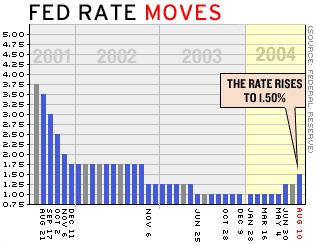NEW YORK (CNN/Money) -
The Federal Reserve raised its target for a key short-term interest rate a quarter-percentage point Tuesday in a continuing effort to raise lending rates from the lowest levels in more than 40 years.
The Fed also gave financial markets reason to believe it was more likely to raise rates again in September. While acknowledging recent signs of a slowdown in economic growth and the labor market, the central bank repeated the view, stated in recent weeks by its chairman, Alan Greenspan, that the slowdown was temporary.
At the end of a one-day policy meeting, the Fed's policymakers unanimously agreed to raise their target for the fed funds rate, an overnight lending rate that influences other rates throughout the economy, to 1.5 percent from 1.25 percent.
The Fed made a similar increase on June 30. Despite the two rate hikes -- the first since May 2000 -- the Fed's target is still for a fed funds rate at a level not seen consistently since 1962.
In the closely watched statement accompanying its release, the Fed repeated its view, first expressed on June 30, that it could probably keep raising rates at a "measured" pace.
"In recent months, output growth has moderated and the pace of improvement in labor market conditions has slowed," the Fed wrote. "This softness likely owes importantly to the substantial rise in energy prices. The economy nevertheless appears poised to resume a stronger pace of expansion going forward."
The Fed also said that although inflation has been "somewhat elevated" this year, "transitory factors" -- namely, higher oil prices -- were likely to blame, and the risks to the economy were balanced between sustainable growth and price stability.
Stock prices, encouraged by the Fed's outlook for the economy, extended earlier gains after the rate hike, which was widely expected.

Treasury bond prices fell, as traders priced in a slightly greater chance of a rate hike at the Fed's next policy meeting, scheduled for Sept. 21.
The implied yield on the fed funds futures contract, a closely watched gauge of market expectations for Fed policy, priced in a roughly 40 percent chance of another quarter-point hike in September.
"If you had to make an unconditional forecast today, it would be that the Fed is going to raise in September," said former Fed Governor Lyle Gramley, now a consulting economist with Schwab Washington Research. "But there's a lot of economic data to come between now and then. If things continue to be as draggy as they have been, the Fed will sit still."
Denial: not just a river in Egypt
Last week, after Friday's government report of weaker-than-expected July job growth, traders put the odds of a September hike at just 15 percent.
| 
| |

| 
| 
|

|
 The The
Federal
Reserve
raised a
key short-term interest rate a quarter-
percentage point, its second increase in the last three months.
|
 Play video
Play video
(Real or Windows Media)
|
| 
|

|
|
Investors and some economists took the jobs report, coming on the heels of a weak June report and downward revisions of previous months' job gains, as a worrisome sign that the Fed's recent prediction of strong second-half economic growth was off the mark.
Some economists, in fact, believed the Fed should not have raised rates at all -- or, at least, should have offered a better explanation for why it did so.
"How could we have such a turnaround in job growth and have the Fed find that it doesn't change its assessment of risks in the economy whatsoever?" asked Robert Brusca, chief economist at Fact & Opinion Economics.
"This is a Fed that should be headquartered in Egypt, because it's in denial."
Putting on a brave face
But Fed officials had painted themselves into a corner, to some degree, with their earlier declarations of confidence.
They may have been nervous about recent economic data in their closed policy meeting on Tuesday, but they couldn't let markets see them sweat. To do so would have cost them credibility on Wall Street, some analysts said.
"Even though, internally, I think they are probably debating it, it's just too early to make an announcement to publicize that debate," said Anthony Chan, senior economist with JP Morgan Fleming Asset Management.
The central bank cut rates 13 times between January 2001 and June 2003, fighting the effects of a recession, terror attacks, corporate scandals, a long bear market in stocks, two wars and the most sluggish job market, by many measures, since the Depression.
Low rates helped fuel a boom in mortgage refinancing, which cut homeowners' monthly bills and put cash in the pockets of consumers, who fuel more than two-thirds of U.S. gross domestic product, the broadest measure of the economy.
GDP growth boomed in the second half of 2003 and continued in the first half of this year, and the labor market finally began to recover. Along with nascent signs of inflation, the Fed had plenty of cover to start raising interest rates from a starting point that many policymakers and economists considered an "emergency" level.
But several factors have conspired to raise some worries about the economy in recent months. For one thing, oil prices shot up to record levels and have stayed stubbornly high, draining discretionary income from consumers and raising costs for businesses.
High oil prices, fears of terror attacks and uncertainty about the outcome of the upcoming presidential election have battered stock prices this summer, putting more downward pressure on the economy.
Despite the Fed's declaration of confidence on Tuesday, further signs of a sluggish economy could keep them on hold in September, according to some observers.
"If the economy does not move out of the soft patch, monetary policy could be on hold beginning September until the economy shows signs of renewed strength," said Sung Won Sohn, chief economist at Wells Fargo.

|